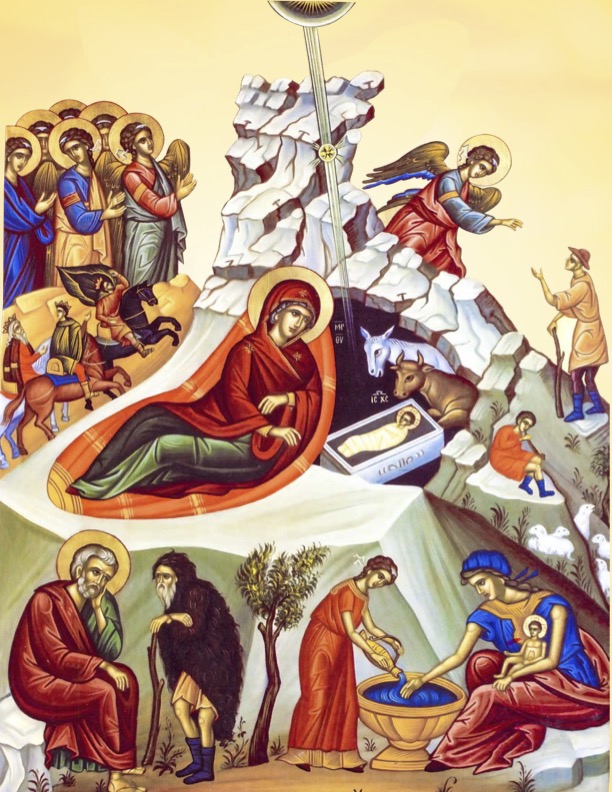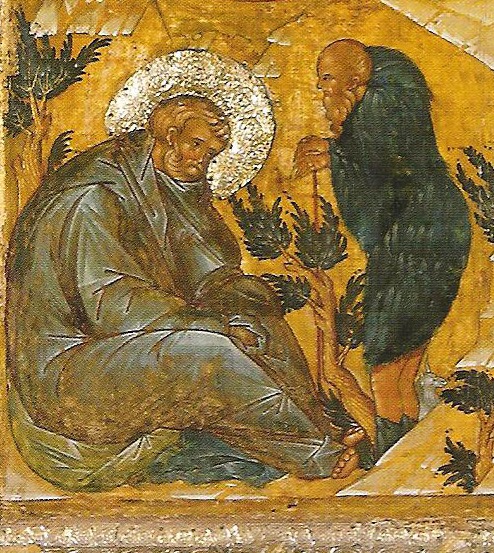He’s down in the left-hand corner of the scene, a bent and crooked little man clothed in a dark wooly covering. Like a shepherd, only more sinister.
“Who’s that guy?” my ten year old son asks, pointing to the unfamiliar figure. He recognizes the other characters in the picture—Mary and an infant Jesus in the middle, flanked by ox and donkey, angels, shepherds, three wise men, and yes, Joseph, who this strange and dark figure is addressing. Joseph looks a little melancholy, a little perplexed, sitting down there in the corner.
“That’s the devil,” I answer.
Three sets of eyebrows raise around the table. Silence.
“Yep, the devil’s in the nativity scene.”
We are looking at a copy of a centuries-old Orthodox icon. An icon is not just a piece of art. Beyond a pretty picture, it is meant to point beyond itself to the deeper nature of reality, and is a reflection of theological truths. I’ve brought out this Icon of the Nativity during Advent so we can learn how early Christians thought about the birth of Christ and its significance.
This little vignette of Joseph and the devil may be unfamiliar to you. (I’ve never seen the devil advertised as part of any nativity set. Why haven’t marketers jumped on this?!) It’s based on a second century story of the events surrounding the birth of Christ. This story is by no means canonical, or authoritative as Scripture, but it does give us insight into very early Christian perspectives on the nativity.
So, what’s the devil doing here? This wolf in sheep’s clothing?
Well, the story goes that after Jesus was born, the devil disguised himself as a hunchbacked shepherd and came to Joseph to sow seeds of doubt in his mind about the whole “virgin birth scenario.”
He holds a weathered old stick, a tool to mock Joseph, saying, “Did God really say that a virgin would give birth to a son who was conceived by the Holy Spirit? Isn’t that about as likely as this dried out stick suddenly sprouting leaves and buds?”
Joseph’s in a tough spot. You could understand his confusion. He can barely explain the situation to himself, let alone the others who snigger behind his back. And maybe he’s feeling a little left out. He’s not at the centre of this scene, basking in the glow of the star-struck infant. He’s just a guy along for the ride, trying to do the right thing, to protect his young wife and child, and just keep putting one step of faith after the other. But it’s been a long road to Bethlehem. And he needs to sit down a minute. He needs a little air.
And it’s here, in this very natural moment of weary perplexity that the shape-shifting Old Scratch appears like an ordinary peasant that just happened to wander down from those hills up there on the right. His strategies are timeless:
“Did God really say … ?”
“Are you sure you aren’t just making this stuff up?”
“Poor Joseph. I know you love the girl, but let’s face reality.”
“All this incarnation nonsense—you think God has really showed up in your pathetic little world?”
Joseph’s eyebrows are furrowed. His drooping head rests on one hand. His eyes are locked on the stranger’s.
At first I was a little put off by the devil’s presence in this oh-so-holy night. But perhaps this icon is closer to reality than many other manger scenes?
There’s a place here for doubt. For fatigue. For wrestling with temptations that don’t disappear when the twinkle lights go up. For an acknowledgement that Christmas is not something we come to without a little fear and trembling and downright puzzlement.
There’s a place here for people who are feeling on the outskirts of joy, who can’t muster up the carols just now. There’s a place for sitting wearily in the left-hand corner of Christmas.
But here’s the thing—Joseph’s still part of the scene. He has’t lost his halo, even though he’s locked eyes with the devil himself. There’s a Light here that embraces even this.
Joseph will resist the temptation, so the story goes, though not in his own power. He will get up, and go on to embrace Mary and her mystery child fully. He will take his place in the gospels as devoted father and protector. Righteous Joseph. But here, for a few minutes, we are invited into his humanity—into an experience by no means unique to him. It’s familiar to all of us.
If you need it, there’s a place beside Joseph for you this year. There, on the rock, where if you look over the hunchback’s shoulder you can see a tree in bloom. You’re still part of the picture, too.
*
Lindsey Gallant
S. D. G.



Lindsey, everything about this post is beautiful. Your words speak to me in my struggles and help me see. Thank you for pointing me past the enemy toward the cradle and the cross.
Thank you, my friend! I was just so oddly encouraged by this little encounter and thought others might be too. The cradle (the cave, the cross, the empty tomb) are still in the centre.